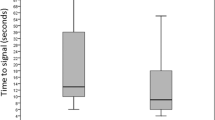Conclusions
Pulse oximetry is a valuable tool but one must not use it blindly. The practitioner must not forget basic assessment skills and be controlled by the machine, but must learn to control the machine available. This way one can ascertain “why” the infant is desaturating, the determine if there is a physiological or environmental cause for an infant’s desaturation.
Similar content being viewed by others
References
Peters LLH, Sheldon RE, Jones MD Jr, et al. Blood flow to fetal organs as a function of arterial content.Am J Obst Gynecol 1979; 135: 637–646.
Orzalesi MM, Hey WW Jr. The regulation of oxygen affinity of fetal blood I. In vitro experiments and results in normal infants.Pediatrics 1971; 48: 857–867.
Oski FA. Clinical implications of oxyhemoglobin curve in the neonatal period. Crit Care Med 1979; 70 412–418.
Delivoria-Papaclopoulus M, Roncevic NP, Oskei FA. Postnatal changes in oxygen transport of term premature, sick and infants. The role of red cell 2, 3-DPG and adult hemoglobin.Ped Res 1971; 5: 235–245.
Niehoff J, Delguercio C, LaMorte W et al. Efficacy of pulse oximetry and capnometry in postoperative ventilatory weaning.Crit Care Med 1988; 16: 701–705.
Shapiro, BA.Clinical application of blood gases. Year Book Medical Publishers, Inc. 1975.
Smith CA, Nelson NM.The physiology of the newborn infant, 4th Edition, Charles C. Thomas, 1976.
Dautzenbery B, Gallinari C, Moreau A, Sors C. The-advantages of real-time oximetry over intermittent arterial blood gas analysis in a chest department. In :Pulse oximetry, Eds Payn & Severinghaus: Springer Verlag 1986.
Deckardt R, Steward DJ. Noninvasive arterial hemoglobin, oxygen saturation versus transcutaneous oxygen tension monitoring in the preterm infant.Crit Can Med 1984; 12: 935–939.
Mok JYQ, McLaughlin FJ, Pintar M et al. Transcutaneous monitoring of oxygenation: What is normal?J Ped 1986; (1083) : 364–371.
Solimano AJ, Smyth JA, Mann TK et al. Pulse oximetry advantages in infants with bronchopulmonary dysplasia.Pediatrics 1986; 78 (5): 844–849.
Durand M, Ramanathan R. Pulse oximetry for continuous oxygen monitoring in siék newborn infants.J Pediatr 1986; 109: 1052–1056.
Ramanathan R, Durand M, Larrazabal C. Pulse oximetry in very low birth weight infants with acute and chronic lung disease.Pediatrics 1987; 79: 612–617.
Jenis MS, Peabody JL, Pulse oximetry: An alternative method for the assessment of oxygenation in new born infants.Pediatrics 1987; 79 : 524–528.
Martin We, Cheney FW, Dillard DH et al. Oxygen saturation vs oxygen tension.J Thorac Cardiovasc Surg 1973; 65: 409.
Boennel AM, Laver MB, Huggins C et al. Oxygen transport and massive transfusion: The unsteady state.Surgical Forum 1970; 21: 52.
House JT, Schultetus RR, Gravenstein N. Continuous neonatal evaluation in the delivery room by pulse oximetry.J Clin Monit 1987; 3: 96–100.
Fanconi S. Reliability of pulse oximetry in hypoxic infants.J Pediatr 1988; 112: 424–427.
Tremper KK, Hufstedler S, Zaccari J et al. Pulse oximetry and transcutaneous PO2 during hemorrhagic and normotensive shock in dogs.Anesthesiology 1984; 61: A163.
Brooks TK, Paulus DA, Winkel WE. Infrared heat lamps interfere with pulse oximeters.Anesthesiology 1984; 61: 630.
Costarino AT, Davis DA, Keon TP. Falsely normal saturation read with the pulse oximeter.Anesthesiology 1987; 67: 830–831.
New W. Pulse oximetry.J Clin Monitoring 1985; 1: 126–129.
Riedel K. Pulse oximetry: A new technology to assess patient oxygen needs in the neonatal intensive care unit.J Perinat Neonatal Nurs 1987; 1 : 49–57.
Bachkert P, Bucher HU, Fallenstein F et al. Is pulse oxymetry reliable in detecting hyperoxemia in the neonate?Adv Exp Med Biol 1987; 220: 165–170.
Author information
Authors and Affiliations
Rights and permissions
About this article
Cite this article
Dziedzic, K., Vidyasagar, D. Non-invasive oxygen saturation monitoring in neonates. Indian J Pediatr 56, 599–605 (1989). https://doi.org/10.1007/BF02722376
Issue Date:
DOI: https://doi.org/10.1007/BF02722376




